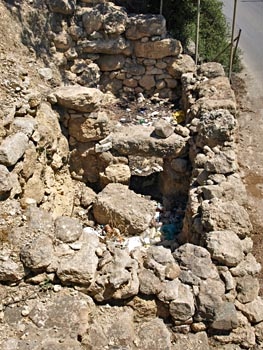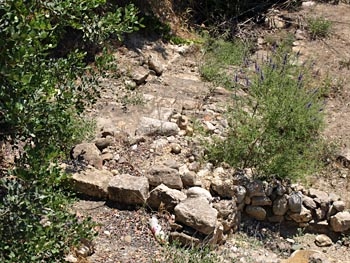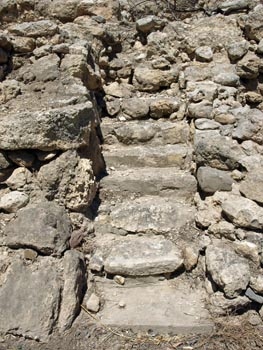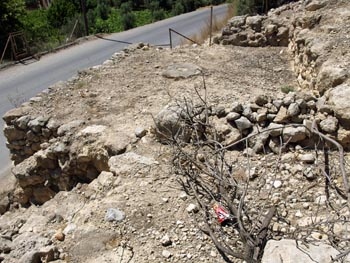Neopalatial villa
The villa of Klimataria is located on the road between Siteia and Ierapetra, a few kilometres south of Siteia. It was originally a country villa dating to the MM IIIB-LM IA period. Unfortunately it had been cut in two by the building of a road and part of the villa was obviously destroyed in the process. The lower part of the building to the east of the road had also suffered damage from a bulldozer. Many blocks were also removed by the owner of the land to dam a nearby river.
The East Wing
On the eastern side of villa there are the remains of two sets of steps descending from west to east, one at the northern end of the building and one at the southern end. The northern steps, are in two sections. The upper section descends as far as a paved landing and an entry into Room A. The steps then continue down to the bottom of the building. Both sections have twelve steps each. Nothing was found below the bottom step and the excavator stated his belief that the river below the building, which now flows further east than in Minoan times, originally ran along the bottom end of the building.
From the upper part of the staircase, two narrow rooms, one paved, can be entered. The upper of the two rooms is thought to be the north gatehouse of the villa. South of the lower set of stairs there are five rooms (A, B Γ, Δ and Ε). Rooms A and Γ are thought to have been storerooms. In Room A, the lower parts of four pithoi were uncovered. They had handles and bore a rope decoration on them and were dated to MM IIIB. Two other pithoi were found in Room Γ which also contained a large piece of slate embedded in the coated floor.
The third room, Δ, had a coated flooring and plaster on its walls. It is not known what the room was used for. The last room on this level, room E, contained so little in the way of finds that it was not possible to allocate a use to this room. West of room E two small, narrow rooms, very similar to those on the north side of the building were uncovered. The upper of these two rooms is thought to have been the southern gatehouse, although its west wall is not preserved. It could be entered from the steps immediately to the south or from the lower of the two rooms. This lower room could also be entered up a few steps from room E.
Apart from the pithoi already mentioned there were almost no finds in the five rooms on the east side of the road. However, a number of sherds were recovered from vessels that had been used for cooking. The excavator concluded that the villa had probably been built in MM III but was mainly used in LM IA.

Rooms Z (foreground) and H (behind) with the small opening between them in the partition wall, covered by a lintel
South of room E the south set of steps was uncovered, although these steps are in much poorer condition than those on the north side of the building. In the top section the steps are not preserved at all and only the carved-out rock shows where the steps were. It is estimated that there were thirty steps in all in the southern staircase, which extended beyond the east facade between two parallel walls. As with the north steps, there was no floor beyond the last step, adding weight to the opinion that the steps originally ended at the river's edge.
West of rooms Γ and Δ there are the remains of three small rooms whose walls are built directly onto the rock. These rooms were not inhabited. It is more likely that they were the foundations for rooms on an upper floor (presumably at the level of the current road). It is not known if they were used as storage areas entered from above using a ladder.
The east facade was constructed of ashlar masonry, preserved to a height of over two metres, thought to have been placed there to withstand the flooding of the river. The facade formed a protruding "bastion" on which a terrace may have been built up to the level of the east rooms.
The West Wing
On the other side of the road, three rooms at the level of the current road were identified and originally named Σ (sigma), Ρ (ro) and Π (pi). The larger part of these rooms had been buried under the road, although the lower remains of two pithoi found in situ in room Π suggest it may have been a storeroom. Between rooms Π and Ρ there was a corridor T (taf), which contained the base of a door jamb for a large door. Corridor T led westwards to a small set of steps that led up to the rooms to the west of the road.
West of rooms Σ, Ρ and Π there are two deep rooms Z (zeta) and H (eta), with walls preserved to a good height. Although it was at first thought that these two rooms communicated with the steps it was found that in fact there was no way in or out of the rooms. They did, however, communicate with each other through a small, low opening in the partition wall. The lintel above this opening is still preserved. However, the small size of the opening caused the archaeologists to wonder what the rooms might have been used for. Clearly they were basement rooms, acting as foundations for an upper floor and it is possible they were entered through a trapdoor down a wooden ladder.
South of the two rooms the small set of eight steps, mentioned above and restored by the archaeologists, separates these rooms from other rooms to the south at a higher level. Here a retaining wall contains a terrace on which a room, only half of which is preserved, was found. (This is labelled I and K in the published plan). In the middle of the terrace there is a pillar base.
In the western section of the villa, apart from a small pithos, only sherds were found. Those north of the steps were dated to LM IA while those to the south were dated to the Middle Minoan period.
Beneath the road, which at the time of the excavation did not have an asphalt surface, the excavators found a room with a small pillar, a corridor with a drain beneath it, a series of three rooms whose eastern sides had been completely destroyed and a hewn set of steps communicating with the south staircase.




